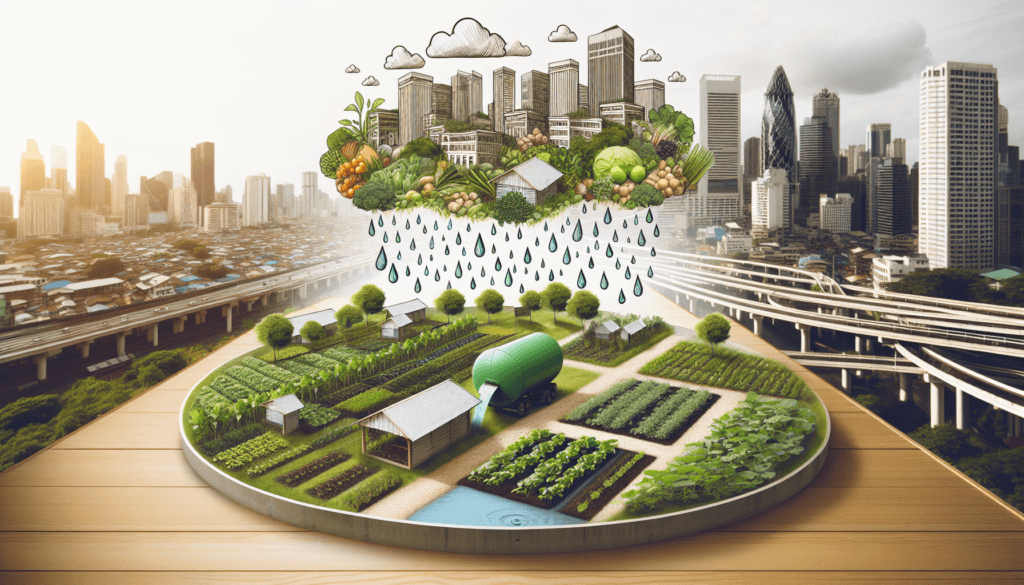Imagine a city with green rooftops, community gardens nestled between towering buildings, and urban farms flourishing amidst the concrete jungle. In this article, we will explore the fascinating world of urban agriculture and its remarkable ability to combat a persistent environmental issue: runoff. By examining the ingenious techniques employed by urban farmers, we will discover how these urban oases are transforming cities into sustainable havens, mitigating the harmful effects of runoff, and cultivating a greener future for all. So grab your virtual gardening gloves and let’s dig into the exciting realm of urban agriculture!

Importance of Reducing Runoff
Reducing runoff is crucial for the protection of the environment and the well-being of communities. Runoff refers to the water that flows over the ground instead of being absorbed into the soil. This excess water picks up pollutants such as chemicals, pesticides, and fertilizers, and carries them into water bodies. It not only degrades water quality but also harms aquatic life and ecosystems.
Moreover, runoff contributes to flooding, erosion, and the depletion of water resources. During heavy rainfall or storms, the excessive water cannot be properly absorbed by the ground, leading to overflow and subsequent damage. This runoff can also carry sediment, which increases the risk of erosion and sedimentation in rivers, lakes, and streams. Additionally, it reduces the amount of water available for groundwater recharge, thus depleting our water supply.
To combat these negative effects, sustainable solutions that prioritize reducing runoff are needed. This is where urban agriculture comes into play.
Definition of Urban Agriculture
Urban agriculture is the practice of growing, processing, and distributing food within urban areas. It encompasses various forms, including rooftop gardens, community gardens, vertical farming, and hydroponics. Furthermore, it embraces both individual and community efforts to produce food in urban environments.
Urban agriculture offers numerous benefits, such as increased access to fresh produce, community engagement, and the promotion of sustainable food systems. However, it is also a powerful tool in reducing runoff and addressing its environmental impacts.

1. Increased Vegetative Cover
One way urban agriculture helps reduce runoff is by increasing vegetative cover in urban spaces. Green roofs and walls, community gardens, and vertical farming all contribute to this goal.
Green roofs and walls
Green roofs and walls involve the installation of vegetation on building rooftops and vertical surfaces. These systems provide multiple environmental benefits, including stormwater management. The plants and soil on green roofs absorb rainwater, reducing the amount of runoff that would otherwise enter storm drains. This not only helps to alleviate pressure on infrastructure but also prevents polluted water from entering water bodies.
Community gardens
Community gardens play a significant role in urban agriculture and reduce runoff through increased vegetative cover. By converting vacant lots or abandoned spaces into green areas, these gardens offer numerous benefits. The soil in community gardens has better water-holding capacity and infiltration rates than paved surfaces or compacted soil, reducing runoff. Additionally, the plants in these gardens help to stabilize the soil and prevent erosion.
Vertical farming
Vertical farming refers to the practice of growing crops in vertically stacked layers. By utilizing vertical space in urban environments, this form of agriculture maximizes productivity while minimizing land use. Vertical farms incorporate hydroponics or aquaponics systems, which use significantly less water compared to traditional farming. This reduction in water usage helps to decrease runoff and conserves water resources.
2. Rainwater Harvesting
Rainwater harvesting is the collection and storage of rainwater for later use, typically for irrigation purposes. This sustainable practice helps reduce runoff and efficiently utilizes a natural resource.
Collection and storage of rainwater for irrigation purposes
In urban agriculture, rainwater harvesting systems are employed to collect and store rainwater for irrigation. Rainwater runoff from rooftops can be directed into rain barrels or cisterns, where it is stored until needed for watering plants. By capturing rainwater and using it during dry periods, urban farmers can reduce their reliance on municipal water supplies and minimize runoff.
Use of rain barrels and cisterns
Rain barrels and cisterns are commonly used in urban agriculture to collect and store rainwater. These storage systems are placed beneath downspouts or gutters to capture rainwater as it runs off roofs. Once collected, the water can be utilized for watering plants, reducing the need for treated water and decreasing runoff.
Benefits of rainwater harvesting
Rainwater harvesting offers numerous benefits in urban agriculture. Firstly, it reduces dependence on municipal water supplies, conserving water resources. Secondly, it reduces the amount of stormwater runoff, alleviating pressure on stormwater management infrastructure. Lastly, rainwater is free from chlorine and other chemicals used in municipal water treatment, making it healthier for plants and reducing the potential for environmental contamination.

3. Soil Health and Erosion Control
Healthy soils play a vital role in reducing runoff and managing stormwater in urban agriculture. By focusing on soil health and implementing erosion control measures, urban farmers can effectively mitigate the negative impacts of runoff.
Importance of healthy soils in reducing runoff
Healthy soils have higher infiltration rates, allowing water to be absorbed rather than becoming runoff. Soil that is rich in organic matter and well-structured retains more moisture and facilitates the infiltration of water. By improving soil health through composting, cover cropping, and reducing soil compaction, urban agriculture can reduce runoff and enhance the water-holding capacity of the soil.
Methods to improve soil health in urban agriculture
To improve soil health in urban agriculture, practices such as composting and cover cropping are employed. Composting involves the decomposition of organic matter, which enriches the soil with nutrients and improves its structure. Cover cropping refers to the planting of temporary crops to protect and nourish the soil between planting seasons. These practices increase organic matter content, enhance soil structure, and contribute to reducing runoff.
Prevention of erosion through soil conservation practices
Erosion can lead to increased runoff and sedimentation in water bodies. To prevent erosion in urban agriculture, soil conservation practices are imperative. Techniques such as contour plowing, terracing, and mulching help to reduce erosion by slowing down the flow of water and preventing soil displacement. By implementing these practices, urban agriculture can effectively manage runoff and protect the environment.
4. Utilization of Permeable Surfaces
Permeable surfaces are an essential element of urban agriculture’s efforts to reduce runoff. Permeable surfaces allow rainwater to infiltrate into the ground instead of becoming runoff.
Explanation of permeable surfaces
Permeable surfaces, also known as porous pavements, are designed to allow water to pass through them. These surfaces consist of materials with increased porosity, such as permeable concrete or interlocking pavers. By replacing traditional impermeable surfaces like concrete with permeable alternatives, the amount of runoff can be significantly reduced.
Benefits of using permeable surfaces in urban agriculture
The use of permeable surfaces in urban agriculture offers several benefits. Firstly, it helps to reduce runoff by allowing rainwater to directly infiltrate into the soil. This facilitates groundwater recharge and reduces the strain on stormwater management systems. Secondly, permeable surfaces prevent the formation of standing water, which eliminates potential breeding grounds for mosquitoes and reduces the risk of waterborne diseases.
Examples of permeable surfaces in urban agriculture
In urban agriculture, permeable surfaces can be incorporated in various ways. Permeable pavements can be used for pathways in community gardens, allowing water to soak into the ground. Additionally, permeable pavers can be utilized for driveways, parking lots, and even green roofs, providing a sustainable solution to manage runoff effectively.

5. Use of Biofiltration Systems
Biofiltration systems are a valuable tool in reducing runoff and treating stormwater in urban agriculture. These systems utilize natural processes to remove pollutants and manage stormwater runoff.
Role of biofiltration in reducing runoff
Biofiltration plays a crucial role in reducing runoff by treating stormwater through biological and physical mechanisms. Through the use of plants, soil, and microbes, biofiltration systems remove pollutants and nutrients from stormwater, preventing them from entering water bodies. This helps to maintain water quality and minimize the environmental impacts of runoff.
Types of biofiltration systems used in urban agriculture
There are various types of biofiltration systems used in urban agriculture, including constructed wetlands, rain gardens, and bioswales. Constructed wetlands are engineered systems that mimic natural wetlands and provide habitat for specialized plants and microorganisms that remove pollutants. Rain gardens are shallow depressions planted with water-loving vegetation, which capture and retain stormwater, promoting infiltration and treatment. Bioswales are vegetated channels designed to slow down and treat stormwater runoff by filtering out pollutants through soil and vegetation.
Advantages and limitations of biofiltration
Biofiltration systems offer numerous advantages in reducing runoff and treating stormwater. They are cost-effective, visually appealing, and have significant environmental benefits. Apart from reducing runoff, biofiltration enhances water quality, supports biodiversity, and creates green spaces in urban areas. However, it is essential to consider the limitations of biofiltration, such as the need for space and maintenance requirements. Proper design, regular maintenance, and monitoring are necessary to ensure the effectiveness and longevity of biofiltration systems.
6. Water-efficient Irrigation Techniques
Water-efficient irrigation techniques are a vital component of urban agriculture to minimize runoff and conserve water resources.
Importance of water-efficient irrigation
Water-efficient irrigation is crucial for urban agriculture as it maximizes water use efficiency and minimizes runoff. By using irrigation methods that deliver water directly to the roots of plants without wastage or overspray, the overall water consumption can be significantly reduced. Water-efficient irrigation promotes healthy plant growth while conserving water resources.
Drip irrigation
Drip irrigation is a water-efficient irrigation technique that delivers water directly to the base of plants using a network of tubes and emitters. This method minimizes water loss due to evaporation, runoff, and wind drift. By applying water precisely where it is needed, drip irrigation reduces runoff and ensures optimal water utilization for plants.
Smart irrigation systems
Smart irrigation systems utilize advanced technology to optimize water usage in urban agriculture. These systems incorporate weather sensors, soil moisture sensors, and computerized controllers to deliver water based on specific plant needs and weather conditions. By providing the right amount of water at the right time, smart irrigation systems reduce runoff by avoiding overwatering and help conserve water resources.

7. Stormwater Management Programs
Collaboration between urban agriculture and stormwater management is crucial for effective runoff reduction. By integrating stormwater management programs into urban agriculture practices, communities can address runoff issues more comprehensively.
Collaboration between urban agriculture and stormwater management
Collaboration between urban agriculture and stormwater management programs allows for the joint implementation of strategies to reduce runoff. By working together, these entities can identify mutual goals and develop coordinated plans for stormwater management in urban agriculture settings. This collaboration ensures that the efforts put into reducing runoff by urban agriculture align with larger stormwater management initiatives, maximizing the positive impacts.
Implementation of regulatory policies
The implementation of regulatory policies is essential to ensure effective stormwater management in urban agriculture. These policies can include regulations on the use of permeable surfaces, rainwater harvesting requirements, and best practices for erosion control. By enforcing and promoting these policies, communities can create a supportive framework for urban agriculture to reduce runoff effectively.
Monitoring and evaluation of stormwater management programs
Continuous monitoring and evaluation of stormwater management programs are necessary to measure their effectiveness and make necessary improvements. By regularly assessing the impact of these programs, communities can identify areas of success and areas for improvement. This feedback loop is crucial in refining strategies and ensuring that stormwater management efforts in urban agriculture remain effective in reducing runoff.
10. Case Studies and Success Stories
To demonstrate the effectiveness of urban agriculture in reducing runoff, it is valuable to examine real-world examples and success stories.
Examples of cities implementing urban agriculture to reduce runoff
Numerous cities around the world have implemented urban agriculture initiatives as part of their efforts to reduce runoff. For instance, Chicago has integrated green roofs, rain gardens, and community gardens into their urban agriculture programs. In Portland, the “Ecoroof” program promotes the installation of green roofs to manage stormwater. These examples serve as inspiration for other cities looking to adopt similar practices and showcase the potential of urban agriculture in reducing runoff.
Positive outcomes and measurable results
Case studies have demonstrated the positive outcomes and measurable results of urban agriculture in reducing runoff. Many cities have seen a decrease in stormwater runoff and improved water quality as a result of implementing urban agriculture practices. Additionally, these initiatives have led to increased community engagement, improved public health, and enhanced urban biodiversity. The measurable results attained through urban agriculture highlight its value in addressing the challenges of runoff while achieving multiple co-benefits.
Lessons learned from successful case studies
Successful case studies provide valuable lessons for communities looking to implement urban agriculture as a runoff reduction strategy. Key lessons learned include the importance of stakeholder engagement, supportive policy frameworks, and proper planning and design. Additionally, effective communication, education, and ongoing monitoring are essential for the long-term success of urban agriculture initiatives. By learning from these case studies, communities can optimize their efforts in reducing runoff through urban agriculture.


